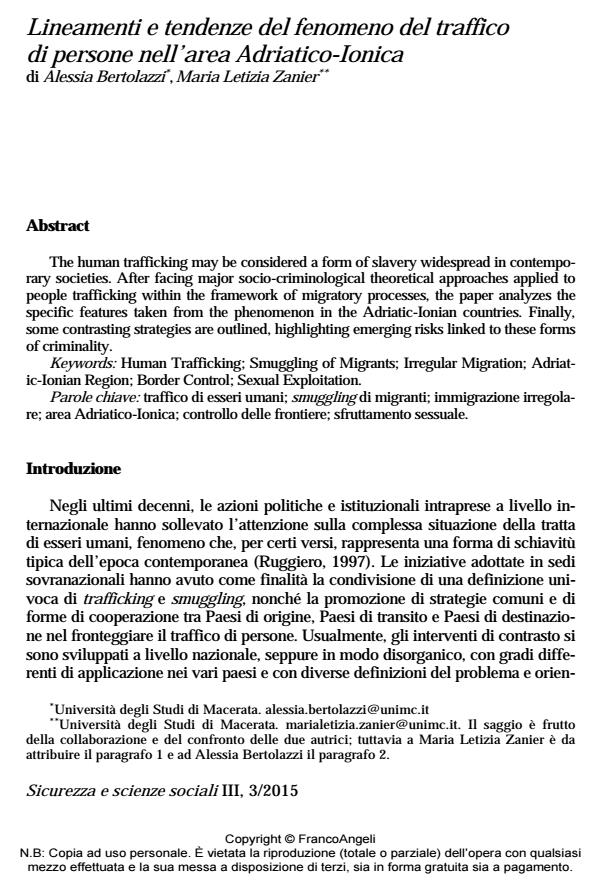Lineamenti e tendenze del fenomeno del traffico di persone nell’area Adriatico-Ionica
Titolo Rivista SICUREZZA E SCIENZE SOCIALI
Autori/Curatori Alessia Bertolazzi, Maria Letizia Zanier
Anno di pubblicazione 2016 Fascicolo 2015/3 Lingua Italiano
Numero pagine 13 P. 48-60 Dimensione file 69 KB
DOI 10.3280/SISS2015-003005
Il DOI è il codice a barre della proprietà intellettuale: per saperne di più
clicca qui
Qui sotto puoi vedere in anteprima la prima pagina di questo articolo.
Se questo articolo ti interessa, lo puoi acquistare (e scaricare in formato pdf) seguendo le facili indicazioni per acquistare il download credit. Acquista Download Credits per scaricare questo Articolo in formato PDF

FrancoAngeli è membro della Publishers International Linking Association, Inc (PILA)associazione indipendente e non profit per facilitare (attraverso i servizi tecnologici implementati da CrossRef.org) l’accesso degli studiosi ai contenuti digitali nelle pubblicazioni professionali e scientifiche
The human trafficking may be considered a form of slavery widespread in contemporary societies. After facing major socio-criminological theoretical approaches applied to people trafficking within the framework of migratory processes, the paper analyzes the specific features taken from the phenomenon in the Adriatic-Ionian countries. Finally, some contrasting strategies are outlined, highlighting emerging risks linked to these forms of criminality.;
Keywords:Traffico di esseri umani; smuggling di migranti; immigrazione irregolare; area Adriatico-Ionica; controllo delle frontiere; sfruttamento sessuale
- Ambrosini M. (2011). Sociologia delle migrazioni. Bologna: il Mulino.
- Brian T., Laczko F., editors (2014). Fatal Journeys. Tracking Lives Lost during Migration. Geneva: IOM International Organization for Migration.
- European Commission (2012). The EU Strategy towards the eradication of trafficking in human beings, 2012-2016., --testo disponibile al sito: http://ec.europa.eu/anti-trafficking/eu-policy/new-european-strategy-2012-2016_en, consultato il 30/06/2015.
- Eurostat (2015). Trafficking in human beings., --testo disponibile al sito: http://ec.europa.eu/anti-trafficking/publications/trafficking-human-beings-eurostat-2015-edition_en, consultato il 29/06/2015.
- anti-trafficking/publications/trafficking-human-beings-eurostat-2015-edition_en, consultato il 29/06/2015.
- Gallagher A. (2001). Human Rights and the New UN Protocols on Trafficking and Migrant Smuggling: A Preliminary Analysis. Human Rights Quarterly, 23: 975-1004. DOI: 10.1353/hrq.2001.0049
- Gallagher A. (2006). Recent Legal Developments in the Field of Human Trafficking: A Critical Review of the 2005 European Convention and Related Instruments. European Journal of Migration and Law, 8: 163-189. DOI: 10.1163/157181606777974941
- Hughes D. (2014). Trafficking in human beings in the European Union: gender, sexual exploitation, and digital communication technologies. Sage Open: 1-8. DOI: 10.1177/215824401455358
- Ifantis K., editor (2012). Adressing Irregular Migration in the Mediterranean. CES Centre for European Studies.
- Kangaspunta K. (2003). Mapping the Inhuman Trade: Preliminary Findings of the Database on Trafficking in Human Beings. Forum on Crime and Society, 3: 81-103.
- Laczko F. (2002). Human trafficking: the need for better data. Migration Information Source., --testo disponibile al sito: http://www.migrationpolicy.org/article/human-trafficking-need-better-data, consultato il 29/06/2015.
- Laczko F. (2007). Enhancing Data Collection and Research on Trafficking in Persons. In: Savona E., Stefanizzi S., editors, Measuring Human Trafficking: Complexities and Pitfalls, New York: Springer.
- Last T., Spijkerboer T. (2014). Tracking Deaths in the Mediterrean. In: Brian T., Laczko F., editors, Fatal Journeys. Tracking Lives Lost during Migration. Geneva: IOM International Organization for Migration, pp. 85-107.
- Monzini P. (2008). Il traffico di migranti per mare verso l’Italia. Sviluppi recenti (2004-2008). CeSPI Working Papers, 48, Roma: CeSPI.
- Monzini P., Pastore F., Sciortino G.(2004). L’Italia promessa: geopolitica e dinamiche organizzative del traffico di migranti verso l’Italia. CeSPI Working Papers, 9, Roma: CeSPI.
- Pastore F. (2008). Lybia’s Entry into the Migration Great Game. In: Guiraudon, V., editor, The external dimension of Immigration and Aylum Policies in Europe. Oxford: Berg Publishers.
- Pastore F., Monzini P., Sciortino G. (2006). Schengen’s Soft Underbelly? Irregular Migration and Human Smuggling across Land and Sea Borders to Italy. International Migration, 44, 4: 95-119. DOI: 10.1111/j.1468-2435.2006.00381.x
- Ruggiero V. (1997). Trafficking in human beings: slaves in contemporary Europe. International Journal of The Sociology of Law, 25: 231-244. DOI: 10.1006/IJSL.1997.0042
- Salt J. (2000). Trafficking and Human Smuggling: A European Perspective. International Migration, 38, 3: 31-56. DOI: 10.1111/1468-2435.00114
- Stocchiero A., a cura di (2014). La strategia dell’Unione Europea per la Regione Adriatico-Ionica e la politica estera italiana. CeSPI e ISTRID, Working Paper, --testo disponibile al sito: http://www.cespi.it/PDF/Macroregione%20Adriatica%20CeSPI%20ISTRID.pdf.
- UNAR (2014). Dossier Statistico Immigrazione 2014. Dalle discriminazioni ai diritti. Roma: Idos.
- United Nations (2000). Protocol to Prevent, Suppress and Punish Trafficking in Persons, Especially Women and Children, Supplementing the United Nations Convention Against Transnational Organized Crime. New York: UNODC
Alessia Bertolazzi, Maria Letizia Zanier, Lineamenti e tendenze del fenomeno del traffico di persone nell’area Adriatico-Ionica in "SICUREZZA E SCIENZE SOCIALI" 3/2015, pp 48-60, DOI: 10.3280/SISS2015-003005